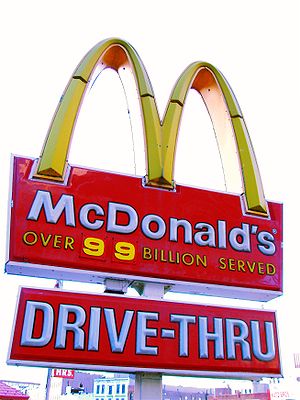I grew up near McDonald’s, and we would often ride our bikes there for a milkshake and fries. A new study confirms what is quite logical:
Got lots of fast food restaurants and other outlets that sell junk food in your neighborhood? Then your teen is more likely to nosh regularly on burgers and fries and wash them down with a soda.
Location, location, location…
The sad part is there are very few places left without the presence of fast food restaurants. In fact, the UCLA study found that three-quarters of California teens live near junk food. If they don’t live near them, they go to school by them. It’s not just fast food restaurants, but convenience stores, gas stations, etc. that feature junk, packaged food also surround our kids.
Not only did I grow up by a McDonalds, there was a Wendy’s right by our high school. Of course, we walked there for lunch, rather than eat the gross cafeteria food.
Using both the 2007 California Health Interview Survey and InfoUSA, a 2007 database of U.S. businesses, the study’s authors calculated a Home and School Retail Food Environment Index, which measured the number of less healthy food outlets relative to the number of healthier outlets surrounding the homes and schools of California teens, and compared that measurement to teen junk food consumption.
They found that the average California teen has more than seven times as many junk food outlets near home and school as healthier food outlets.
And teens in more unhealthy neighborhoods were 17 percent more likely to drink soda every day and 18 percent more likely to eat fast food at least twice a week than their peers in healthier neighborhoods.
“It is a travesty that our kids have better access to liquor stores and other unhealthy food outlets than a grocery store,” said Robert K. Ross, M.D., president and CEO of the California Endowment, which funded the study. “We have put our children and youth in harm’s way, and they are paying the price for our carelessness. If nothing is done, this will be the first generation to live shorter lives than their parents.”
The authors recommend solutions of…
better zoning, especially around schools, and farm-to-school programs that bring fresh produce into school cafeterias. They also noted that better incentives were needed to bring healthy food outlets, such as farmers markets and grocery stores, into underserved neighborhoods.
Parents can petition existing stores to carry more whole foods, educate their children on the risks of fast food, pack home lunches and snacks, etc. Teenagers will follow what they think is cool, so parents need to unite to really make a change in the whole peer group. You can also stay involved in community planning and make sure no new fast food or junk outlets appear in your neighborhood.
We are surrounded by junk food!

[…] some of these statistics in a slide deck for a clueless client, but this report is on par with a study that says children who live near fast food restaurants tend to eat more junk food. In these cases, common […]